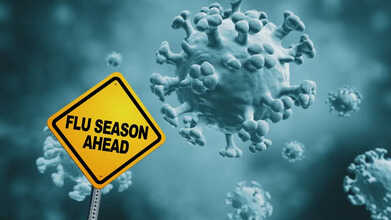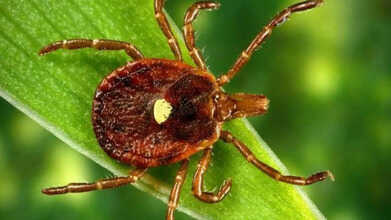- Health Conditions A-Z
- Health & Wellness
- Nutrition
- Fitness
- Health News
- Ayurveda
- Videos
- Medicine A-Z
- Parenting
NHS Doctor Gives Flu Shot Warning Amid Concern Over A Mutated Strain Hitting Children Harder

Credits: Canva
NHS doctor and regular BBC guest star Dr Punam has shared a warning about a flu variant that appears to be more severe for children than strains seen in previous years. Speaking on BBC Morning Live on Friday, she explained why many in the medical field are paying close attention to the current flu season.
Dr Punam noted that people often brush off flu concerns, but this winter is prompting far more worry. She pointed out that the rise in cases normally appears toward the end of November. This year, however, the surge began in early October. According to her, this has left many people without adequate protection, as recent NHS vaccination drives have tended to start later in the year.
She repeated that the early spike is unusual and has added to concerns. She also highlighted that a new form of the virus has now appeared. She said the usual strain has undergone a mutation during the summer. Health services look to Australia each year for early signs, and their winter season has been especially harsh, giving the UK a strong indication of what may come.
What Is The New Flu Strain Spreading in UK?
The current form of H3N2 is moving quickly across several regions. Dr. Wenqing Zhang, who leads the World Health Organization’s Global Respiratory Threats Unit, said at a recent media briefing that it has begun to dominate in a number of Northern Hemisphere countries.
James Mackey, head of the U.K.’s National Health Service, added that this winter may be one of the most demanding periods staff have ever handled. Experts do not see this as a situation on the level of a pandemic, but it still poses notable risks for older adults and those who already live with health conditions.
The doctor strongly encouraged eligible groups to get their flu vaccinations without delay. She also stressed that the new strain could be more damaging for children than those seen previously. The children’s flu vaccine is available for those aged 2 to 3 years, school-aged children from Reception to Year 11, and children with certain chronic conditions. If a child has missed their scheduled dose, parents can book a free NHS appointment through a pharmacy or the NHS App.
Who Is Eligible For A Free NHS Flu Jab This Autumn And Winter?
- Pregnant women
- All children who were aged 2 or 3 years on August 31, 2025
- Children with certain long-term health conditions (aged 6 months to under 18 years)
- Primary school aged children (Reception to Year 6)
- Secondary school aged children (Year 7 to Year 11)
- All children in clinical risk groups aged 6 months to under 18 years
- Everyone aged 65 and older
- Adults aged 18 to under 65 with certain long-term conditions
- Residents in care homes
- Carers receiving Carer’s Allowance or those who support an older or disabled person
- People living with someone who has a weakened immune system
- Frontline health and social care workers
Will This Year’s Flu Shot Be Helpful?
Every February, global health agencies and vaccine manufacturers identify which strains to include in the flu shot for the Northern Hemisphere by studying the patterns seen in the Southern Hemisphere. This year’s vaccine covers three types of influenza, including two influenza A strains and one influenza B strain.
The flu shot does not completely stop infection, but it helps reduce how sick a person becomes. Last year’s dose was up to 55 percent effective at keeping adults with flu out of the hospital.
This week, UK health officials released early data showing that the current vaccine may lower the risk of hospitalization among adults by up to 40 percent.
Hitler Likely Had Rare Genetic Sexual Disorder, DNA Study Finds

Credits: Public Domain
Adolf Hitler may have lived with a rare genetic disorder known as Kallmann Syndrome, according to researchers and documentary producers who carried out DNA testing on what they say is the Nazi leader’s blood. The Cleveland Clinic notes that this condition can interfere with the start of puberty and may result in traits such as undescended testicles and a micropenis.
The new findings also rule out a long-standing rumor that Hitler had Jewish heritage, the research team said.
Hitler Likely Had Kallmann Syndrome, New DNA Investigation Suggests
For decades, wartime songs and jokes poked fun at Hitler’s genitalia, though none of those claims had scientific support. Now, an international group of historians and scientists believes their results strengthen theories about abnormalities in his sexual development.
Alex Kay of the University of Potsdam said the diagnosis could help explain Hitler’s lifelong distance from women and his probable lack of intimate relationships. “No one has really been able to account for his discomfort with women,” Kay noted, as per CBS News, “If he had Kallmann Syndrome, this may offer the explanation that has been missing.”
The full findings appear in an upcoming documentary titled Hitler’s DNA: Blueprint of a Dictator.
What Is Kallmann Syndrome?
Kallmann syndrome is an inherited condition in which puberty is either greatly delayed or does not begin at all, and the affected person also has a reduced or absent sense of smell. It stems from a shortfall of gonadotropin-releasing hormone (GnRH), a key hormone that signals the body to start puberty and develop sexual characteristics.
In this disorder, certain neurons that should move from the nasal region to the brain during early development do not reach their destination. As a result, the sense of smell is impaired and the olfactory bulbs remain poorly formed. The syndrome may appear alongside other birth defects and is seen far more often in males.
How Researchers Obtained Hitler’s DNA
As per The Guardian, according to the team, the genetic material was taken from a fragment of fabric believed to come from the sofa where Hitler killed himself. Their analysis pointed to a high likelihood of Kallmann Syndrome.
Britain’s Guardian, which reviewed the documentary, cautioned that the researchers were unable to collect new DNA from any of Hitler’s surviving relatives in Austria or the United States. Those family members, the newspaper said, declined participation because they wished to avoid publicity.
Claims And Criticism Around Psychological Predispositions
Producers at Blink Films, which created the documentary, reported that the DNA sample showed unusually high polygenic risk scores for autism, schizophrenia, and bipolar disorder. The Guardian highlighted that many experts remain skeptical of using these scores to comment on an individual’s mental health risk.
David Curtis, an honorary professor at University College London’s Genetics Institute, told the newspaper that such scores speak to trends in large groups, not to precise predictions about one person. Even someone in the highest percentile may still face only a small actual chance of developing a condition.
The research team added that even if Hitler had these predispositions, they could not excuse or rationalize his political decisions or the atrocities carried out under his command. World War II claimed more than 50 million lives, including six million Jews murdered in the Holocaust.
Geneticist Turi King, known for identifying the remains of King Richard III and who contributed to this project, remarked that the results place Hitler among the groups targeted by his own eugenics policies. “If he had been able to examine his own DNA,” she said, “he almost certainly would have condemned himself.”
DNA Findings Reject Myth of Jewish Ancestry
The study also challenges the rumor that Hitler’s paternal grandmother became pregnant by a Jewish employer. According to the production team, Y chromosome evidence matches that of Hitler’s known male-line relative, which would not have been possible if the pregnancy had resulted from an unrelated man.
The myth resurfaced in 2022 when Russia’s foreign minister, Sergei Lavrov, invoked it while defending the invasion of Ukraine and repeating the Kremlin’s claim that its goal was to “denazify” a country led by Jewish president Volodymyr Zelenskyy.
What Is Behind The Rise In Whooping Cough Cases Across The United States?

Credits: Canva
Multiple states across the United States have reported a rise in whooping cough this year. On Nov. 3, the Texas Department of State Health Services released a notice describing a “significant increase” in cases, with 3,500 infections reported from January through October 2025.
This figure is four times higher than the number seen during the same period in 2024. Two days later, on November 5, the Mississippi State Department of Health announced that whooping cough cases have “dramatically increased,” reaching 130 so far this year.
What Is Whooping Cough?
Whooping cough, also known as pertussis, is a highly contagious respiratory infection caused by the bacterium Bordetella pertussis. It usually begins with symptoms similar to a simple cold but can progress to intense coughing spells that create a “whooping” sound when a person breathes in, as per Cleveland Clinic.
These coughing fits can lead to vomiting or short pauses in breathing, especially in babies. The illness is particularly dangerous for infants, although routine vaccination offers strong protection for people of all ages.
Whooping Cough Symptoms
Whooping cough develops in stages. The incubation period, which is the time between exposure and the first symptoms, can range from five to 21 days. The illness progresses through three stages.
The first resembles a mild cold, with tiredness, low fever, coughing, sore throat, watery eyes, and nasal congestion. The second stage can last from one to ten weeks and is known for severe coughing fits called paroxysms, vomiting, and the well-known “whoop” that follows a coughing spell. Cleveland Clinic notes that recovery forms the third stage, which can last up to six weeks.
Symptoms may shift as a person moves through the phases.
- Initial stage (1 to 2 weeks): Symptoms mirror a common cold, including a runny nose, sneezing, light cough, and low-grade fever.
- Paroxysmal stage (after 1 to 2 weeks): The cough becomes harsher and arrives in bursts. Breathing in after a fit can create a high-pitched “whoop.” In this stage, some people may experience:
- Vomiting after coughing spells
- Blue or purple skin due to low oxygen
- Short pauses in breathing (apnea), especially in infants
- Recovery stage: Coughing fits begin to ease but may linger for several weeks or months.
Whooping Cough: Why Are Whooping Cough Cases Increasing In the US?
Experts link this rise to dropping vaccination rates, especially among children, which makes it easier for the infection to spread. Specialists warn that vaccination is the strongest tool to keep numbers under control. They also point out that whooping cough often increases in cycles every few years, and the illness cannot be fully eliminated.
“We practitioners and public health professionals are concerned because we are seeing a year-after-year trend of a significant increase in cases when this is preventable,” said Hector Ocaranza, a pediatrician and member of the Texas Medical Association’s Council on Science and Health Promotion, as per Texas Tribune. “Especially a disease that can have such a severe effect on infants, older people, and those who have chronic conditions.”
The agency’s latest alert, issued on November 3, also mentioned that more than half of last year’s cases appeared in November and December, suggesting that numbers may keep rising.
Whooping Cough: Who Are More Vulnerable?
Babies younger than six months face the highest risk because they have not yet completed their vaccination schedule. One in three infants with whooping cough needs hospital care, and one in five may develop pneumonia. Some babies experience seizures or swelling in the brain. Many infants do not cough but instead gag or turn blue or purple due to long pauses in breathing that may last more than 20 seconds, a condition known as life-threatening apnea.
Healthy teenagers and adults can also catch the infection and may develop pneumonia, along with coughing fits that cause vomiting, exhaustion, and sometimes rib fractures. However, the chance of death is much lower in older children and adults. If treated early, antibiotics can ease symptoms and limit the spread of the illness.
The Texas health department notes that vaccination remains the strongest form of protection and urges parents to ensure that children are current on their pertussis shots.
Alpha Gal Syndrome: First Death Linked To Tick-Borne Meat Allergy Alarms Health Experts; Know The Warning Signs

Credits: CDC
Alpha gal: The first recorded death linked to alpha-gal syndrome, a dangerous allergy to red meat that can develop after a tick bite, has been confirmed. UVA Health shared on Thursday that the victim was a 47-year-old man from New Jersey who had enjoyed good health until a family camping trip in the summer of 2024.
One evening, he and his family ate steak around 10 p.m. A few hours later, at about 2 a.m., he woke with sharp stomach pain, vomiting, and diarrhea. By morning he felt stable again, and told his son, “I thought I was going to die.” Two weeks later, after eating a hamburger at a barbecue around 3 p.m., he fell sick again.
He went to the bathroom at 7:20 p.m. His son found him on the floor ten minutes later, unconscious and surrounded by vomit. Emergency services were called while the son attempted CPR.
Paramedics continued trying to revive him for nearly two hours as he was taken to the hospital, but he was pronounced dead at 10:22 p.m. An autopsy showed no major issues with his heart, brain, lungs, or abdomen, and the medical examiner recorded the case as “sudden unexplained death.”
When Platts-Mills and the UVA Health team tested a blood sample, they discovered the man had become highly sensitive to alpha-gal. The results showed a reaction pattern similar to what is seen in fatal anaphylaxis, a severe allergic response marked by breathing trouble and widespread hives.
What Is Alpha Gal Syndrome?
Alpha-gal syndrome (AGS) is a meat allergy that develops after bites from certain ticks, most often the lone star tick. People with AGS react to mammalian meat such as beef, pork, or lamb, and sometimes to other products made from mammals.
Symptoms do not appear right away. They usually surface between two and six hours after eating foods that contain alpha-gal. Doctors diagnose AGS by reviewing symptoms, checking IgE antibody levels, and seeing whether a patient improves after avoiding mammalian meat. Treatment focuses on steering clear of foods and items that contain alpha-gal and reducing the risk of future tick bites, according to the Mayo Clinic.
Alpha Gal Syndrome: First Death Linked To Tick-Borne Meat Allergy
Platts-Mills learned from the man’s wife that her husband had been bitten 12 or 13 times by tiny mites called chiggers that summer. After looking more closely, the doctor realised that many of those bites were actually from young lone star ticks. The Independent reported that Platts-Mills and his team believe a beer the man drank on the day he died, along with ragweed pollen exposure, may have intensified his reaction.
Alpha Gal Syndrome: What Is Leading To Alpha Gal Syndrome?
Although lone star ticks were once thought to be the only source of alpha-gal sensitisation, researchers have now found that two more species can trigger the condition. Deer ticks and western black-legged ticks have also been linked to AGS. Tick activity rises during warmer months, placing people in much of the eastern United States at greater risk.
Scientists think that when a tick bites, it may introduce the alpha-gal sugar molecule into the bloodstream, which can set off changes in the immune system. After that, eating beef, pork, lamb, or other mammalian products can cause a delayed allergic reaction.
Alpha Gal Syndrome: Early Warning Symptoms
Early signs of AGS may include hives, itching, stomach cramps, nausea, vomiting, diarrhea, or general abdominal discomfort, usually beginning two to six hours after eating red meat or dairy.
Some people may also develop wheezing, trouble breathing, light-headedness, or a dangerous reaction known as anaphylaxis. Anyone who experiences severe symptoms such as breathing difficulty or a sudden fall in blood pressure should get medical help right away.
About 110,000 possible cases were recorded in the United States between 2010 and 2022, though experts believe the real number may be higher. Because symptoms appear long after a meal, many people go undiagnosed or struggle to connect their reactions to the foods they ate.
© 2024 Bennett, Coleman & Company Limited

